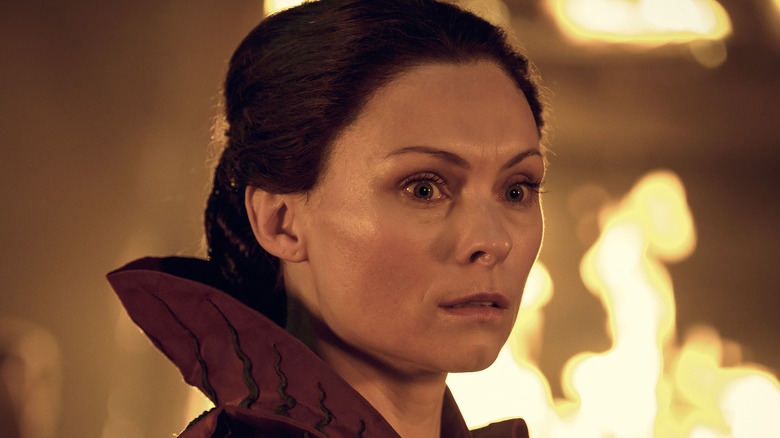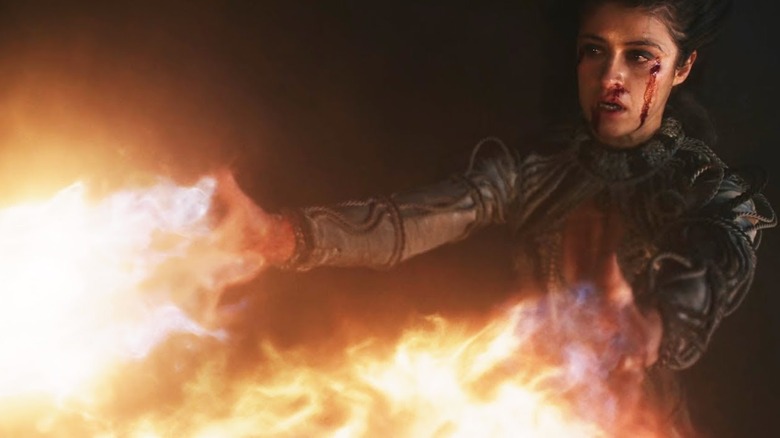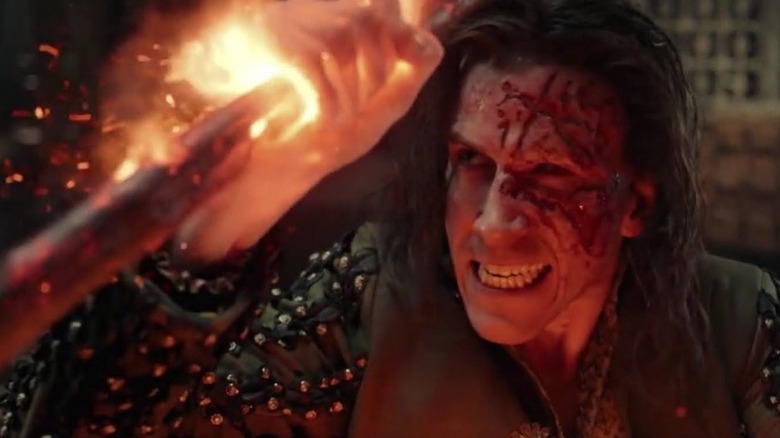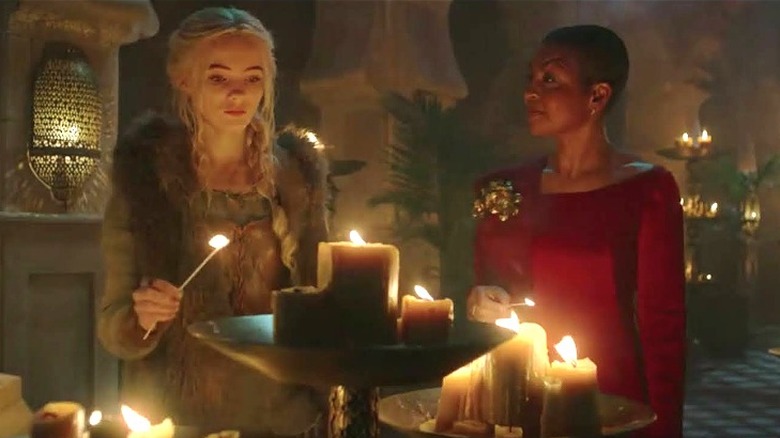How Exactly Does The Fire Magic In The Witcher Season 2 Work?
Spoilers ahead for "The Witcher" Season 2
At the onset of Season 2 of Netflix's "The Witcher," which picks up closely after the tumultuous and tragic events at the Battle of Sodden Hill, we learn that Yennefer (Anya Chalotra) has lost her ability to conjure and control Chaos, a.k.a. magic. Presumably, the loss is the price she paid (the "sacrifice," as MyAnna Buring's Tissaia de Vries calls it) for using fire magic to turn the tide and hold back the Nilfgaardian troops during the hard-fought battle between the southern empire and the northern kingdoms.
In Season 1, Triss Merigold (Anna Shaffer) refers to fire magic as "forbidden" alongside demonology and necromancy, to which Mimi Ndiweni's Fringilla — in defending Nilfgaard's use of it — says "there is no such thing as dark or light magic. Nothing in this world is as simple as that." Truer words have never been spoken when it comes to the intricacy and complexity of the world Andrzej Sapkowski created.
But what exactly is "fire magic," and why is it that it appears to drop Nilfgaardian mages to their knees in Season 1, while Season 2's malevolent mercenary Rience (Chris Fulton) is able to call on it again and again in his merciless quest for Ciri (Freya Allan)? Rience explains that it extracts a heavy and very particular price from its practitioner (its practitioner's "soul," to be precise), but as it turns out, true fire magic is more than just throwing fireballs (an option in the games) and "playing" with fire.
Fire magic has a specific definition
Following the release of Season 1, some fans of the original "The Witcher" books and games were perplexed by Episode 8's depiction of fire magic. In the episode, Fringilla instructs her fellow Nilfgaardian mages to conjure immense balls of fire and catapult them in the direction of Sodden Hill. The first mage who does so is reduced to ash, and Fringilla looks away as the same thing happens to the next. For her part, Yennefer is able to redirect the immense fireballs, yet she suffers no consequences. As user ReinMiku asked other fans on the series' subreddit, "In the show we see mages ... instantly dying after casting a single fireball spell. The hell is this about? Not once in any of the books did they describe anyone dying after casting a fireball."
While the user's observation of the novels is correct, there's nonetheless a distinction between true fire magic — as in, using the actual element of fire (as opposed to water, earth, or air) as the source of one's Chaos — and simply creating fire in a spell. In other words, if one were to draw a fire spell's necessary Chaos from another element, it's not technically "fire magic." In the Season 1 finale, prior to setting the entire hill and the remainder of Nilfgaard's army ablaze by conjuring a veritable firestorm, we see Yennefer in silhouette, her back to the viewer and a burning building in the near distance. The camera then captures Yennefer's fingertips, which have begun to glow with the same fire we see vanishing from the building itself as she recalls all the many injustices she's faced in her life. This is an important scene, and one that speaks to both "The Witcher" world's distinction between fire energy and the other elements, and the various ways in which the force affects the characters in Season 2.
As a source of Chaos, fire corrupts
Yennefer draws her Chaos from the burning building's fire in her efforts to hold back the Nilfgaardian army, but in order to do so, she had to focus intently on all the rage and hate bubbling up inside of her. At the start of Season 2, she's been cut off from Chaos, presumably for doing just that, despite the necessity of it at the time. This has everything to do with both Sapkowski's (largely unspoken but clearly demonstrated) explanation of the mechanics of fire energy, and the actual science behind what fire does. Unlike water, air, and earth, fire does only one thing: it consumes. In order to draw Chaos from it, a magic practitioner must lean into whatever negative forces happen to be consuming them.
This is demonstrated vividly in a scene in Chapter 6 of "The Witcher" novel "The Time of Contempt," wherein Ciri finds herself in desperate need of Chaos and sees her quickly diminishing campfire as the most efficient source. "Yennefer has forbidden me from touching fire energy," she thinks to herself, "but I don't have a choice!" Without giving too much away for those who've not yet read the books, although she successfully uses the fire's energy to save the life of another, she is nearly corrupted — or, consumed by it — in the process.
But, if this is the case, and drawing one's Chaos directly from fire inevitably ends badly, how is it that the mysterious villain of Season 2, Rience, is able to wield it? By his own admission, Rience is corrupted from the start. He's kicked out of Ban Ard Academy for theft, goes on to become a trained killer for the Kaedweni Secret Service, and clearly prioritizes the power fire grants him over his own soul. In short: it's difficult to consume what was never there to begin with.
Fire is both a force and a theme in The Witcher
Although the difference between using fire energy to conjure Chaos and using another form of energy to conjure Chaos in the form of fire might seem like a technicality, it plays an enormous role in one of the underlying themes of Sapkwoski's novels and, inevitably, Lauren Schmidt Hissrich's television adaptation. Again and again in "The Witcher" novels, we see characters consumed by an obsession with power, or an obsession with obtaining the means to achieve that power. As for those already in power, they are largely corrupt. Part of the narrative draw of characters like Yennefer and Ciri is the fact that — because they are powerful — they must constantly fight their own power's ability to consume them. Ciri, in particular, as the priestess Nenneke (Adjoa Andoh) reminds Geralt (Henry Cavill), is at risk of going either way.
As a tangible manifestation of the corrosive nature of power, fire is an equally layered tool. Proactively, it can only destroy or consume. However, there are certain instances wherein something must be burned to the ground before it can be rebuilt. Subsequently, and like many other things in "The Witcher" universe, fire isn't, in and of itself, a force of evil. Much like information, "monsters," blood, and prophecy, it's all about the lens through which it is viewed, and the motivations and circumstances behind its weaponization.



